The Nigersaurus, boasting a remarkable 500 teeth, might sound like a creature from a nightmare. However, its dental layout was a marvel of evolution, designed for efficient herbivory. Sporting constantly replenished teeth every 14 days, this dinosaur's specialized jaw structure allowed it to graze close to the ground, extracting nutrients effectively. The jaws, wider than its skull, revolutionized its feeding habits, making the most of vegetation processing. Despite its tooth overload, the Nigersaurus thrived through its unique feeding adaptations. A wealth of intriguing details awaits those intrigued by this prehistoric dental enigma.
Key Takeaways
- Nigersaurus had up to 500 teeth arranged in rows for efficient herbivory.
- Constant tooth replacement every 14 days prevented wear and maintained feeding prowess.
- Unique tooth arrangement and wide mouth adapted for grazing low-lying vegetation.
- Specialized jaw structure aided in precise browsing close to the ground.
- Dental overload evolution in Nigersaurus showcased efficient feeding adaptations.
The Nigersaurus: A Toothsome Behemoth
The Nigersaurus, a colossal dinosaur known for its abundance of teeth, roamed the ancient landscapes with its unique feeding mechanism. This prehistoric giant possessed a skull lined with up to 500 teeth, making it a true marvel of evolution.
The first discovery of Nigersaurus skull bones in the Republic of Niger by paleontologist Philippe Taquet revealed a wide-mouthed creature with over 500 tiny teeth designed for a specialized diet. These slender teeth, unlike those of other dinosaurs, were perfect for cropping vegetation close to the ground.
The Nigersaurus' skull, with its numerous small teeth, allowed for efficient herbivory as it grazed on plants during the Cretaceous period. This unique feeding adaptation provided it with an evolutionary advantage, enabling the dinosaur to thrive in its ancient environment.
The structure of its skull and teeth offers valuable insights into the dietary habits and ecological niche of this remarkable specimen.
Unraveling the 500-Teeth Mystery
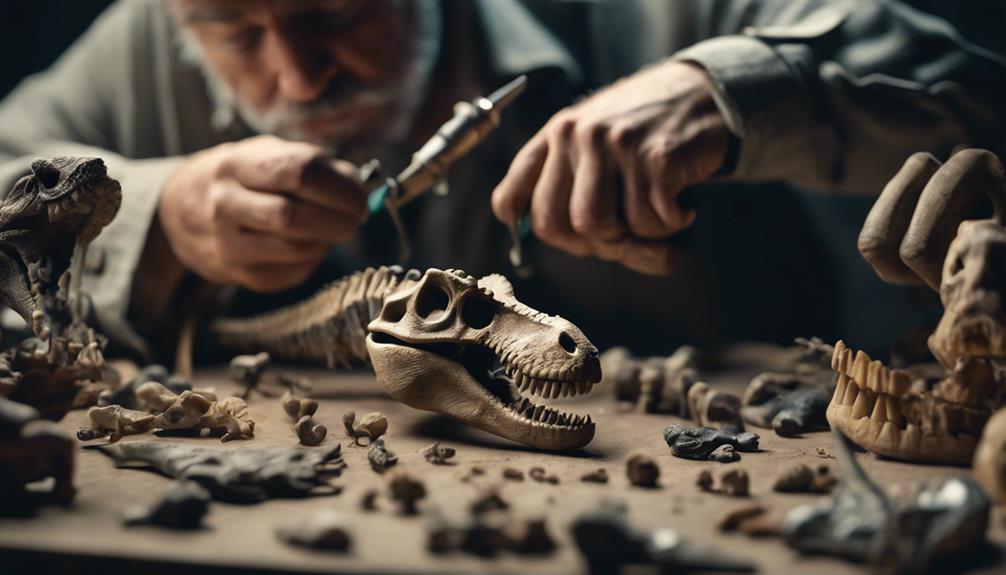
Delving into the mystery of the Nigersaurus' 500 teeth reveals a remarkable evolutionary adaptation for efficient herbivory. This dinosaur's feeding mechanism is a marvel of nature, with its wide mouth and slender teeth allowing it to graze on vegetation close to the ground.
The Nigersaurus' teeth were constantly replaced every 14 days, a unique feature that prevented wear on the tooth crowns and maintained continuous efficient feeding. Unlike its sauropod relatives, the Nigersaurus boasted jaws broader than its skull, a distinct anatomical trait that aided in its specialized feeding habits.
Despite being relatively small compared to other sauropods, measuring around 30 feet long and weighing about four tons, the Nigersaurus' 500 teeth and feeding adaptations set it apart as a fascinating and enigmatic dinosaur in the prehistoric world. The intricate interplay between its jaw structure, tooth replacement cycle, and herbivorous diet showcases the sophistication of evolution in optimizing feeding efficiency.
Dental Arsenal of the Nigersaurus
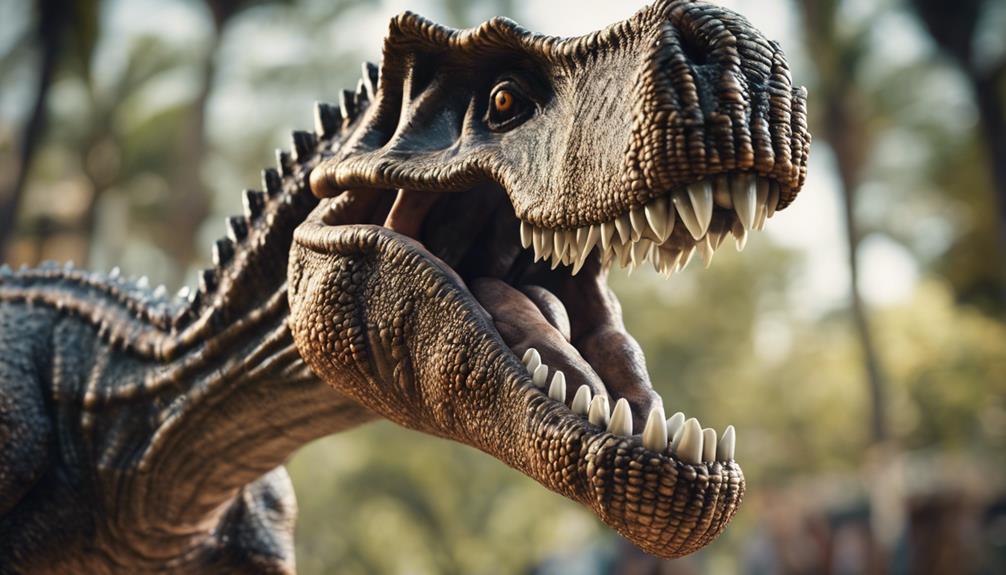
The Nigersaurus possessed a remarkable dental structure that contributed to its distinctive feeding behavior. Its slender teeth and constant replacement cycle every 14 days played an essential role in preventing wear and tear on the tooth crowns.
Tooth Structure Analysis
Analyzing the dental structure of the Nigersaurus reveals a remarkable adaptation for efficient plant consumption through its unique tooth arrangement. This dinosaur with 500 teeth had slender, pencil-shaped teeth that were constantly replaced to maintain functionality.
The Nigersaurus possessed a specialized dental arsenal suited for browsing low-lying vegetation, as its physical limitations prevented it from lifting its head high. The rapid replacement rate of its teeth was a key feature, with new teeth emerging every 14 days to guarantee a full set was always present.
This continuous renewal process allowed the Nigersaurus to sustain its wide mouth and numerous teeth, facilitating the efficient processing of plant material. The tooth structure analysis of the Nigersaurus highlights the evolutionary adaptations that enabled this ancient herbivore to thrive in its environment by optimizing its feeding capabilities for consuming vegetation.
Feeding Behavior Insights
With its wide mouth and slender teeth, the Nigersaurus exhibited a unique feeding mechanism that set it apart from other herbivorous dinosaurs. The wide mouth of the Nigersaurus, combined with its numerous slender teeth aligned in a straight row, allowed for efficient grazing on vegetation close to the ground.
This dinosaur's feeding behavior insights suggest that it was adapted to a specific diet of low-lying plants, as it couldn't raise its head high due to its skull structure. The replacement of teeth every 14 days prevented excessive wear on the tooth crowns, ensuring the Nigersaurus could continuously feed without dental issues.
Another distinctive feature was its jaws being broader than its skull, a rare characteristic among tetrapods. Despite being relatively small compared to other sauropods, measuring 30 feet long and weighing around four tons, the Nigersaurus thrived through its specialized feeding adaptations.
Evolutionary Dental Adaptations
Possessing an evolutionary marvel, the Nigersaurus boasted a significant dental arsenal consisting of up to 500 teeth. These teeth were a product of intricate evolutionary adaptations that enabled this dinosaur to efficiently process plant material.
The continuous replacement of its teeth every 14 days was a key feature that allowed the Nigersaurus to maintain its feeding efficiency. The wide mouth and slender teeth of this dinosaur were specifically designed to facilitate browsing plants close to the ground, ensuring it could consume large amounts of vegetation to sustain its large body.
Prehistoric Dental Nightmare
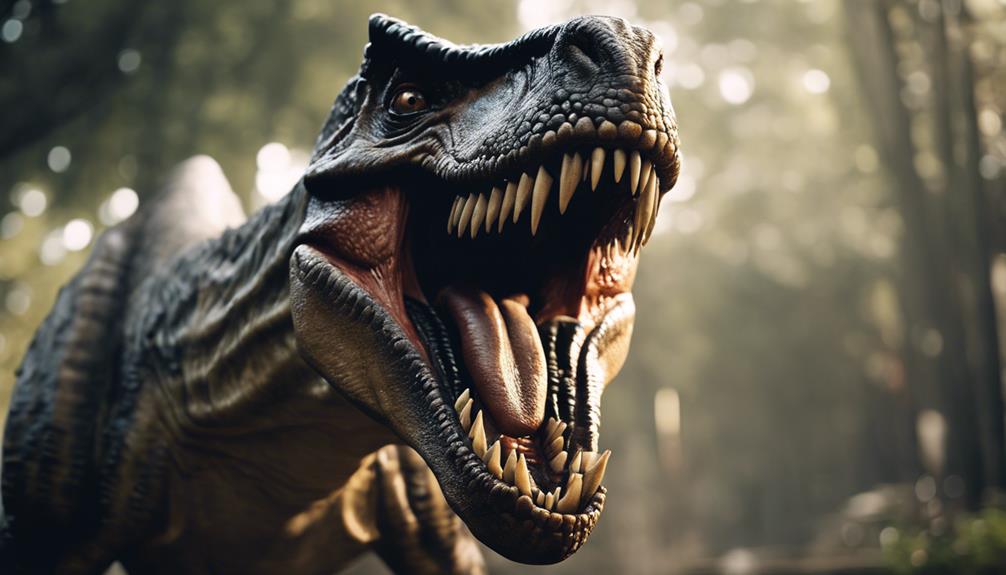
The Nigersaurus's 500 teeth present a fascinating case of tooth overload evolution in the prehistoric era, showcasing the incredible diversity of dental adaptations in ancient creatures.
Its dental nightmare status stemmed from a chomping challenge unlike any other, as it continuously replaced worn teeth every 14 days to maintain its tooth-lined arsenal.
This fossilized dental diversity highlights the unique evolutionary paths taken by different prehistoric species, offering insights into their feeding behaviors and ecological niches.
Tooth Overload Evolution
Evolution sculpted a prehistoric dental nightmare through the tooth overload of the unique Nigersaurus, equipped with an astonishing jaw lined with over 500 slender teeth. These teeth played an essential role in Nigersaurus' feeding habits, allowing it to efficiently consume vast amounts of vegetation.
Unlike other dinosaurs, Nigersaurus had a distinct way of foraging due to its wide mouth and broad jaws, enabling it to graze close to the ground. To maintain its feeding prowess, the dinosaur's teeth were constantly replaced every 14 days, ensuring that it could continue to thrive on low-lying plants.
Despite its dental peculiarity, Nigersaurus was relatively small compared to other sauropods, measuring around 30 feet in length and weighing about four tons. The reconstruction of Nigersaurus' skull bones through CT scans revealed the intricate structure of its teeth, shedding light on its exceptional dental evolution and specialized feeding strategy.
Dental Diversity Display
Nigersaurus' jaw, packed with an extraordinary 500 teeth, showcased a prehistoric dental nightmare with regards to sheer diversity and functionality. The dental diversity of Nigersaurus was truly remarkable, with teeth arranged in rows to form a highly efficient grinding surface. These teeth were continuously replaced every 14 days to counteract wear from the constant browsing of low-lying plants, ensuring uninterrupted feeding.
This unique adaptation allowed Nigersaurus to maintain its feeding habits despite the immense wear on its teeth. Additionally, the sheer number of teeth in Nigersaurus' jaw was unparalleled among dinosaurs, contributing to its distinctive appearance and feeding mechanism. With jaws wider than its skull, Nigersaurus displayed an unusual feature not seen in other tetrapods.
Despite being relatively small compared to other sauropods, measuring 30 feet in length and weighing around four tons, Nigersaurus' dental structure was a standout feature in the world of prehistoric creatures.
Chomping Challenge Fossil
Challenging the norm in prehistoric dentistry, the fossilized remains of the Chomping Challenge exhibit a dental nightmare of epic proportions. This fossil belongs to the Nigersaurus, a dinosaur known for its wide mouth and an astonishing 500 teeth.
The Nigersaurus had a unique feeding mechanism, with jaws broader than its skull, allowing it to browse plants close to the ground. Its slender teeth were constantly replaced every 14 days to prevent wear, a fascinating adaptation in prehistoric dental care.
Despite being relatively small compared to other sauropods, measuring 30 feet long and weighing around four tons, the Nigersaurus's dental structure remains a subject of awe and curiosity in the scientific community.
- The Nigersaurus had a feeding mechanism tailored to its wide mouth and slender teeth.
- Replacement of teeth every 14 days prevented wear on tooth crowns.
- Its jaws were broader than its skull, a unique feature among tetrapods.
- Despite its relative size, the Nigersaurus boasted an impressive dental structure with 500 teeth.
Nigersaurus: Tooth Count Marvel
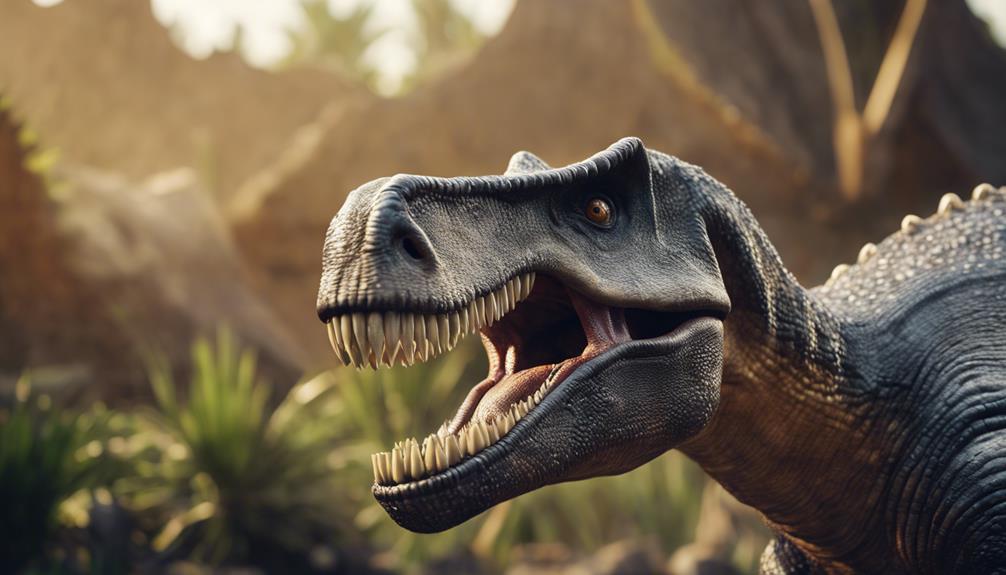
With its astonishing skull boasting up to 500 teeth, Nigersaurus truly stands out as a tooth count marvel among dinosaurs. This long-necked herbivore had a wide mouth lined with rows of slender teeth, a unique feature that set it apart from other dinosaurs.
A fascinating find during an expedition revealed a Nigersaurus skeleton measuring about 15 feet in backbone curve, shedding light on the anatomy of this ancient creature. The team's careful excavation also unearthed a baby Nigersaurus jaw, indicating the presence of hatchlings less than a year old.
Despite its relatively small size compared to other sauropods, the Nigersaurus, measuring around 30 feet long and weighing approximately four tons, had a specialized feeding mechanism suited for browsing plants close to the ground. This remarkable dinosaur's dental configuration and feeding habits offer valuable insights into its evolutionary adaptation and ecological niche during the Cretaceous period.
Evolutionary Tooth Overload

The evolutionary overload of teeth in Nigersaurus's skull was a striking feature that distinguished it from other dinosaurs. This dental structure, with its staggering count of up to 500 teeth, was a marvel of evolution.
The abundance of teeth in Nigersaurus's skull wasn't just a significant occurrence but a specialized adaptation that played a vital role in its survival. Here are some key points to ponder regarding this evolutionary tooth overload:
- Nigersaurus's teeth were uniquely arranged in rows along its jaws, allowing for efficient feeding.
- The continuous replacement of teeth guaranteed that Nigersaurus maintained a functional dental structure throughout its life.
- The discovery of Nigersaurus and its dental adaptation provided valuable insights into the diverse ways dinosaurs evolved to meet their dietary needs.
- The sheer number of teeth in Nigersaurus's skull highlighted the incredible diversity of dental adaptations that existed in the dinosaur kingdom.
Nigersaurus Dental Structure Revealed
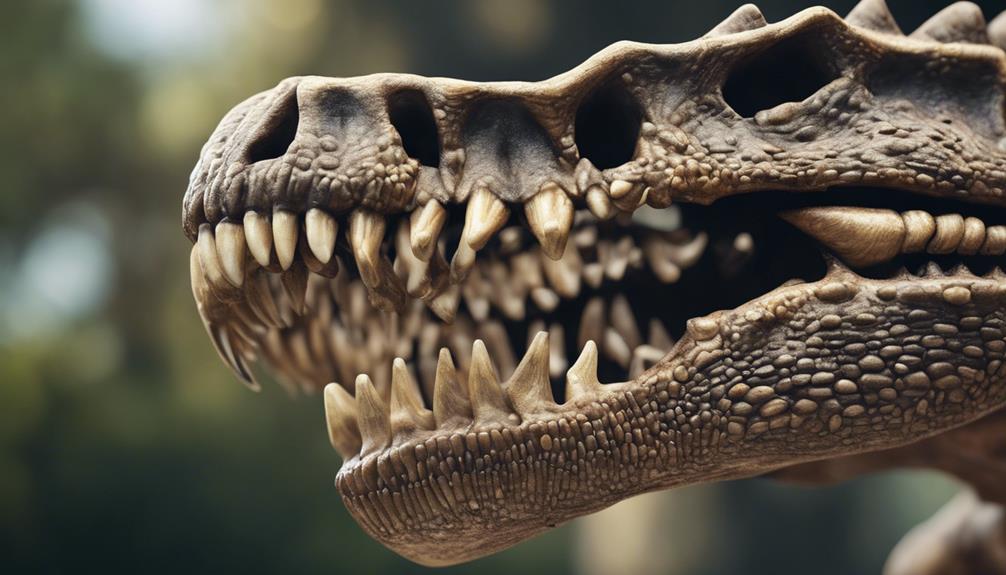
Researchers revealed the intricate dental structure of Nigersaurus through digital reconstruction using CT scans. This dinosaur, known for its unique feeding mechanism, had up to 500 slender teeth in its skull.
The discovery of the first Nigersaurus skull bones in the Republic of Niger shed light on its fascinating anatomy. Nigersaurus possessed a wide mouth and tiny teeth that allowed it to browse plants close to the ground with precision. By digitally reconstructing the Nigersaurus skull, scientists uncovered its jaw structure, which was broader than its skull, a feature rarely seen among tetrapods.
This detailed analysis provided insights into how Nigersaurus adapted to its environment and thrived as a herbivorous dinosaur. The revelation of its dental structure not only showcases the intricate evolution of prehistoric creatures but also highlights the importance of advanced imaging techniques in paleontological research.
The Enigma of 500 Teeth

The astonishing presence of 500 teeth in Nigersaurus remains a perplexing enigma in paleontological studies. This dinosaur's sheer number of teeth raises questions about its feeding habits and the evolution of its unique dental structure.
Some possible explanations for this enigmatic feature include:
- Essential Feeding Mechanism: The abundance of teeth in Nigersaurus may have been essential for its feeding strategy, allowing it to efficiently consume plant material.
- Vital Tooth Replacement: The rapid growth and replacement of teeth every 14 days in Nigersaurus suggest a specialized mechanism to prevent wear and maintain functionality.
- Crucial Tooth Shape: The slender shape of Nigersaurus' teeth indicates a design tailored for a specific diet or feeding behavior, potentially involving the consumption of soft vegetation.
- Jaw Adaptations: The broader jaws of Nigersaurus, exceeding the width of its skull, hint at unique anatomical adaptations possibly linked to its feeding preferences and strategies.
These facets of Nigersaurus' dental structure contribute to the ongoing mystery surrounding the evolutionary adaptations that led to the development of 500 teeth in this intriguing dinosaur.
Nigersaurus Dental Diversity
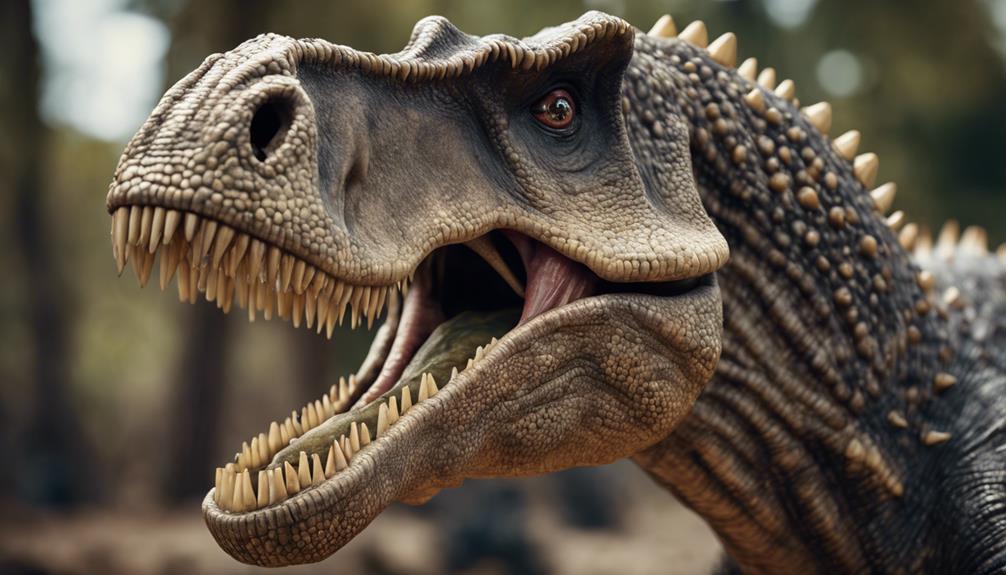
Nigersaurus' dental diversity is a fascinating aspect of this ancient creature's anatomy. The arrangement and function of its 500 teeth provide insights into its unique feeding habits and dietary preferences.
Understanding how these slender teeth worked together in Nigersaurus' wide mouth sheds light on the evolutionary adaptations that allowed this dinosaur to thrive in its environment.
Nigersaurus Tooth Arrangement
Sporting a unique dental arrangement with up to 500 teeth in its skull, the Nigersaurus exhibited a remarkable adaptation for efficiently consuming vegetation. Its teeth weren't only numerous but also uniquely structured, allowing for effective plant consumption. The tooth arrangement of the Nigersaurus played a vital role in its feeding habits:
- The teeth were positioned in rows along the edges of its jaw, creating a continuous cutting surface.
- Each tooth was pencil-shaped and pointed, ideal for slicing through vegetation.
- The Nigersaurus had multiple generations of teeth in each socket, enabling constant replacement and ensuring continuous feeding.
- This adaptation allowed the dinosaur to graze on plants close to the ground with remarkable efficiency, showcasing the effectiveness of its specialized dental structure.
The Nigersaurus tooth arrangement was a marvel of evolution, perfectly suited to its herbivorous diet and providing insights into the diverse adaptations of dinosaurs for survival.
Function of 500 Teeth
Possessing an impressive array of 500 teeth, Nigersaurus showcased a remarkable dental diversity optimized for its herbivorous diet. These teeth weren't only numerous but also constantly replaced every 14 days, ensuring their functionality.
The dinosaur's feeding mechanism was unique, thanks to its wide mouth and slender teeth that were adapted for browsing plants close to the ground. One of the most distinctive features of Nigersaurus was its jaws, which were broader than its skull, a pivotal characteristic among tetrapods. This jaw structure allowed for efficient processing of plant material, supporting its herbivorous lifestyle.
Jaws of the 500-Toothed Dinosaur
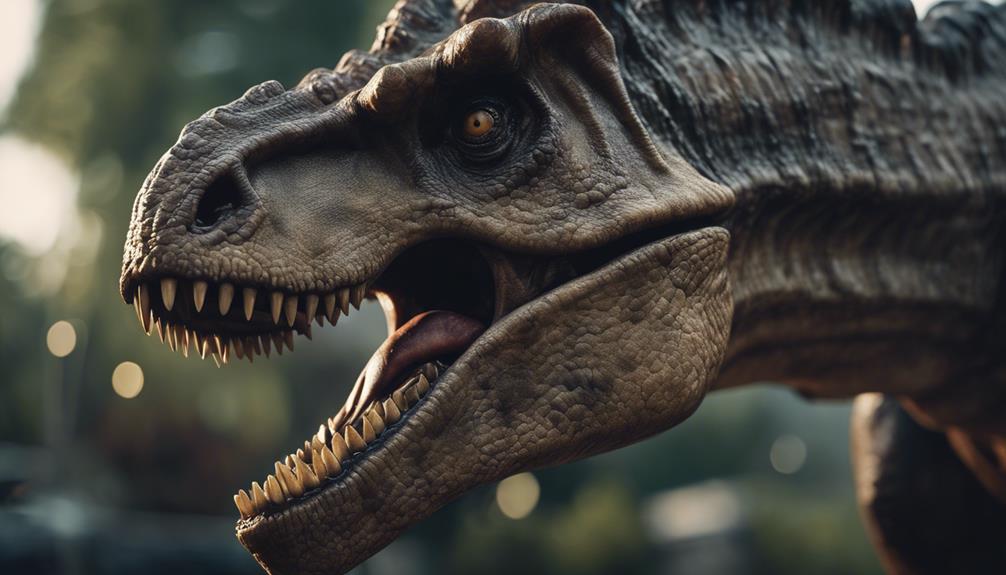
With its wide mouth and slender teeth specialized for browsing low-lying plants, the 500-toothed dinosaur exhibited a unique feeding adaptation. The jaws of the Nigersaurus played an essential role in its feeding behavior, allowing this remarkable dinosaur to efficiently consume vegetation despite its inability to raise its head high. Here are some key aspects of the jaws of the Nigersaurus:
- Broad Jaws: The Nigersaurus boasted jaws broader than its skull, a distinctive feature that set it apart from other tetrapods.
- Efficient Feeding: The specialized jaw structure of the Nigersaurus enabled it to browse close to the ground with precision, ensuring it could extract nutrients effectively.
- Unique Dental Structure: The 500 teeth in the Nigersaurus' mouth, arranged in multiple rows, facilitated its continuous tooth replacement cycle, important for maintaining its feeding efficiency.
- Size Adaptation: Despite its relatively small size compared to other sauropods, the Nigersaurus' jaw morphology and dental arrangement were perfectly suited to its browsing habits.
Frequently Asked Questions
What Dinosaur Has 10000000000 Teeth?
A dinosaur with 10000000000 teeth does not exist in the fossil record. However, the Nigersaurus, a long-necked dinosaur, had a skull with up to 500 teeth. Its unique feeding mechanism enabled it to feed on plants close to the ground.
What Dinosaur Has the 500 Teeth Trend?
Nigersaurus, a dinosaur with a unique feeding mechanism and slender teeth, is known for having 500 teeth. Its wide mouth allowed it to browse low-lying plants efficiently, distinguishing it from other dinosaurs.
Who Named Nigersaurus?
The paleontologist who named Nigersaurus was Philippe Taquet. He chose the name to honor Niger, the country where the dinosaur fossils were discovered. Taquet's decision to name the dinosaur after the region highlights its significance in paleontological research.
How Do You Pronounce the Dinosaur With 500 Teeth?
The dinosaur with 500 teeth is pronounced nee-zhayr-sawr-us. Its correct pronunciation, with the g sounding like j, is essential for accurate communication about this intriguing dinosaur with a unique dental structure.
Conclusion
To sum up, the Nigersaurus with its 500 teeth remains a fascinating prehistoric creature that continues to intrigue scientists and paleontologists alike.
The sheer number of teeth in its jaw challenges our understanding of dinosaur anatomy and evolution.
Imagine the awe and wonder of uncovering such a dental marvel, shedding light on the mysteries of ancient life on Earth.
The Nigersaurus truly is a toothsome behemoth that captivates our imagination and pushes the boundaries of scientific discovery.









